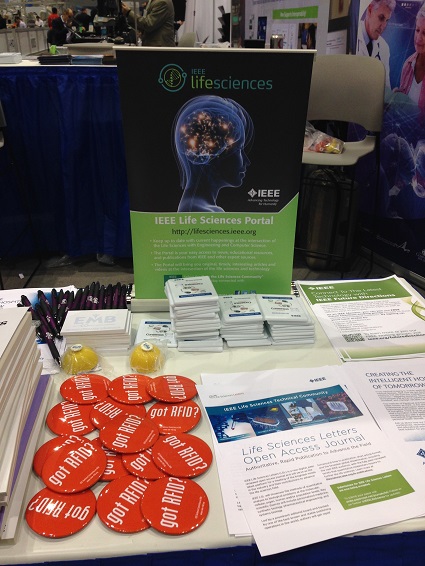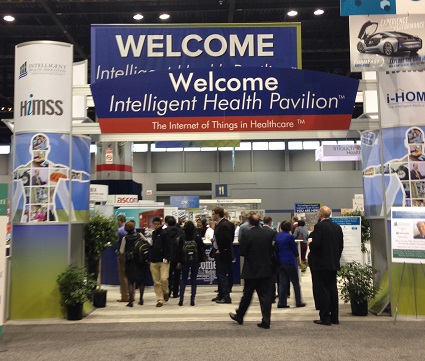HIMSS15: The Latest and Greatest in Healthcare IT on Display in Chicago
From 12-16 April, approximately 40,000 people converged at McCormick Place in Chicago, Illinois, for the 2015 HIMSS Annual Conference—the largest health IT event in the industry. Keynote speakers and industry booths brought attendees together to view the latest in healthcare IT and debate topics ranging from mobile health to device standardization.
Amongst the vast exhibitor space, IEEE Life Sciences had a presence near the Intelligent Hospital Pavilion (Figures 1 and 2).

Figure 1: IEEE Life Sciences on display at HIMSS15.

Figure 2: Attendees gather to enter the Intelligent Hospital Pavilion at HIMSS15 in Chicago.
The increasing size and breadth of the conference underscores the fact that the healthcare environment is in the midst of rapid change, and that there are both many opportunities as well as challenges in this wide-ranging field. In his keynote address, Bruce D. Broussard, CEO and President of Humana, noted that a significant amount of money is currently being lost in healthcare systems because for too long the focus has been on the supply side versus consumer demands. Hence, care and its supporting technology need to shift more toward wellness and health outcomes. Movement in this direction can be seen in efforts such as the Qualcomm Tricorder XPRIZE (see “All-in-One: Multipurpose Healthcare Tool Takes Us Into the Future” in this issue), which aims to bring the ability to manage wellness to every person anywhere, anytime. This theme is also supported by the rapid rise in consumer interest and associated research in wearable sensors that measure health and fitness, as well as support rehabilitation.
In fact, a day was devoted to presentations on wearables in the Intelligent Hospital Pavilion—Wearables Wednesday—where speakers from academia and industry presented their visions of the technology’s future. Bill Crounse, MD, Senior Director of Worldwide Health at Microsoft, spoke of a future where these devices will be replaced by our surrounding environment as the technology becomes part of our appliances and homes. He also predicted that within 1-2 years, non-invasive glucose sensing will be available, which will become a “tipping point” in the wearables field. Others, including Dr. Guang-Zong Yang, Director and co-founder of the Hamlyn Centre at Imperial College London, shared how effective design and placement of wearable body sensors mimics nature, blending easily into our daily lives to become ubiquitous. In this issue, Dr. Benny Lo, also associated with the Hamlyn Centre (Figure 3), and his colleagues discuss the emerging field of assistive wearable robotics.
Figure 3: Dr. Benny Lo, Lecturer at the Hamlyn Centre and the Department of Surgery and Cancer at Imperial College London, watches a display near a mannequin featuring wearable robots and sensors from the Hamlyn Centre.
Throughout the event, what was made increasingly clear is that healthcare and wellness are at an intersection and that to become truly effective, interoperability of devices and data are essential. Karen DeSalvo, MD, National Coordinator for Health Information Technology at the U.S. Department of Health and Human Services (HHS), emphasized in her address that “interoperability is really only a means to an end,” which is better care for all. Andy Slavitt, Acting Administrator for the Centers for Medicare & Medicaid Services (CMS), echoed this sentiment, adding that a lack of interoperability will no longer be considered acceptable by patients, caregivers, or government agencies. In support of this important initiative, this issue’s video profile features the work of Julian Goldman, MD, and associates as they seek to bridge the interoperability gap and set the stage for open standards.







 Denis Huen is an M.Res. candidate in Medical Robotics and Image Guided Intervention at the Hamlyn Centre for Robotic Surgery, Imperial College London. He is interested in fields related to nanotechnology, biomedical engineering, and biologically inspired robotics. Currently, his research focuses mainly on assistive wearable robotics for healthcare applications.
Denis Huen is an M.Res. candidate in Medical Robotics and Image Guided Intervention at the Hamlyn Centre for Robotic Surgery, Imperial College London. He is interested in fields related to nanotechnology, biomedical engineering, and biologically inspired robotics. Currently, his research focuses mainly on assistive wearable robotics for healthcare applications.  Jindong Liu is a research fellow at the Hamlyn Centre for Robotic Surgery, Imperial College London. He is interested in fields related to biologically inspired mobile robotics. He obtained a PhD in Computer Science from the University of Essex where he built a biologically inspired autonomous robotic fish. Between 2008-2010, he studied the computational human auditory system and developed a computational mammalian auditory system applied to the sound localization on mobile robotics at University of Sunderland. In 2010, he joined the Hamlyn Centre, Imperial College London. Now he is focusing on natural human-robot speech interaction, pervasive sensing, and medical robots.
Jindong Liu is a research fellow at the Hamlyn Centre for Robotic Surgery, Imperial College London. He is interested in fields related to biologically inspired mobile robotics. He obtained a PhD in Computer Science from the University of Essex where he built a biologically inspired autonomous robotic fish. Between 2008-2010, he studied the computational human auditory system and developed a computational mammalian auditory system applied to the sound localization on mobile robotics at University of Sunderland. In 2010, he joined the Hamlyn Centre, Imperial College London. Now he is focusing on natural human-robot speech interaction, pervasive sensing, and medical robots.  Benny Ping Lai Lo is Lecturer at the Hamlyn Centre and the Department of Surgery and Cancer, Imperial College London. Dr. Lo received his PhD in Computing from Imperial College London. His research interests include body sensor networks, pervasive computing, microelectronics, Bayesian networks, computer vision, temporal tracking, machine learning, image segmentation, and wearable robotics.
Benny Ping Lai Lo is Lecturer at the Hamlyn Centre and the Department of Surgery and Cancer, Imperial College London. Dr. Lo received his PhD in Computing from Imperial College London. His research interests include body sensor networks, pervasive computing, microelectronics, Bayesian networks, computer vision, temporal tracking, machine learning, image segmentation, and wearable robotics.